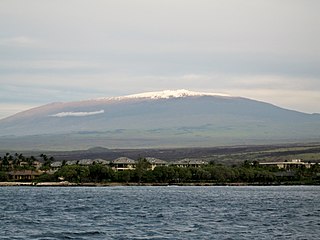
Mauna Kea is an inactive volcano on the island of Hawaiʻi. Its peak is 4,207.3 m (13,803 ft) above sea level, making it the highest point in the state of Hawaii and second-highest peak of an island on Earth. The peak is about 38 m (125 ft) higher than Mauna Loa, its more massive neighbor. Mauna Kea is unusually topographically prominent for its height: its wet prominence is fifteenth in the world among mountains, at 4,205 m (13,796 ft); its dry prominence is 9,330 m (30,610 ft). This dry prominence is greater than Mount Everest's height above sea level of 8,848.86 m (29,032 ft), and some authorities have labeled Mauna Kea the tallest mountain in the world, from its underwater base. Mauna Kea is ranked 8th by topographic isolation.

The Mauna Kea Observatories (MKO) are a group of independent astronomical research facilities and large telescope observatories that are located at the summit of Mauna Kea on the Big Island of Hawaiʻi, United States. The facilities are located in a 525-acre (212 ha) special land use zone known as the "Astronomy Precinct", which is located within the 11,228-acre (4,544 ha) Mauna Kea Science Reserve. The Astronomy Precinct was established in 1967 and is located on land protected by the Historical Preservation Act for its significance to Hawaiian culture. The presence and continued construction of telescopes is highly controversial due to Mauna Kea's centrality in native Hawaiian religion and culture, as well as for a variety of environmental reasons.

Argyroxiphium is a small genus of plants in the family Asteraceae. Its members are known by the common names silversword or greensword due to their long, narrow leaves and the silvery hairs on some species. The silverswords belong to a larger radiation of over 50 species, including the physically different genera Dubautia and Wilkesia. This grouping is often referred to as the silversword alliance. Botanist P. H. Raven referred to this radiation as "the best example of adaptive radiation in plants".

Hibiscus waimeae is a species of flowering plant within the okra family, Malvaceae, that is endemic to the island of Kauaʻi in Hawaii.
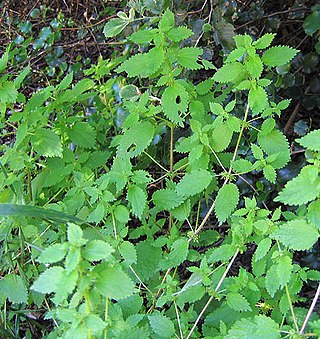
Hesperocnide tenella, also known as western nettle or western stingingnettle, is native to California and northern Baja California. It grows in chaparral, oak woodland, and coastal sage scrub communities up to 1,000 metres (3,300 ft) elevation.

Argyroxiphium sandwicense, the Hawaiʻi silversword, or hinahina is a species of silversword. It is endemic to Hawaii. The two subspecies are separated by geography. Both subspecies are rare, threatened and federally protected.

Hibiscadelphus giffardianus is a species of flowering plant in the mallow family Malvaceae that is endemic to the Big Island of Hawaii.

Dubautia arborea, the tree dubautia or Mauna Kea dubautia, is a species of flowering plant in the family Asteraceae. A member of the silversword alliance, it is endemic to the island of Hawaiʻi. It is a shrub or small tree. It is an endangered species that is threatened by feral grazing animals.
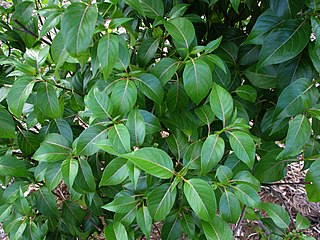
ʻAhakea or Hawaiʻi dogweed is a species of flowering tree in the coffee family, Rubiaceae, that is endemic to Hawaiʻi. It inhabits lava plains as well as dry, coastal mesic and mixed mesic forests at elevations of 100–1,220 metres (330–4,000 ft) on the islands of Oʻahu, Molokaʻi, Lānaʻi, and Maui. It is threatened both by habitat loss and competition from invasive species.

Eurya sandwicensis, the ānini or wānini, is a species of flowering plant in the family Pentaphylacaceae, that is endemic to Hawaiʻi. It is threatened by habitat loss.
Melicope paniculata, the Lihue melicope, is a rare species of tree in the family Rutaceae. It is endemic to the Hawaiian Islands. Like other Hawaiian Melicope, this species is known as alani.
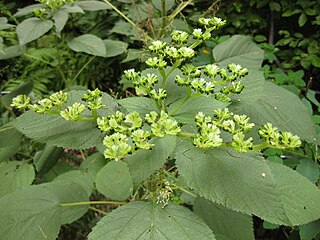
Laportea canadensis, commonly called Canada nettle or wood-nettle, is an annual or perennial herbaceous plant of the nettle family Urticaceae, native to eastern and central North America. It is found growing in open woods with moist rich soils and along streams and in drainages.

Colubrina oppositifolia, known as kauila in Hawaiian, is a rare species of flowering tree in the family Rhamnaceae endemic to Hawaii.

Argyroxiphium sandwicense subsp. sandwicense, the Mauna Kea silversword, is a highly endangered flowering plant endemic to the island of Hawaiʻi of Hawaii. It is the "crown jewel" of the volcanic mountain Mauna Kea, from which it derives its English name. The Hawaiian name is ʻahinahina; it applies to silverswords more broadly. The Mauna Kea silversword was once common on the volcano, and extraordinary conservation efforts are being made to preserve the species.

Phytolacca sandwicensis, also known as Hawai'i pokeweed, is a member of the Phytolaccaceae family and is a flowering and fruit bearing species endemic to the Hawaiian Islands, where it is found on Kauaʻi, Oʻahu, Molokaʻi, Maui, and Hawaiʻi. Locally it is referred to as pōpolo kū mai and/or pōpolo.Pōpolo itself is a term for any Solanum species, which its berries resemble.

Oliarus polyphemus, the Hawai'i cave planthopper, is a species of Oliarus planthopper endemic to the island of Hawai'i, where it inhabits lava tubes and crevice networks embedded in solidified lava flows.

Pittosporum hosmeri, or Kona cheesewood, is a species of tree in the Pittosporaceae family. It is endemic to the island of Hawai'i.
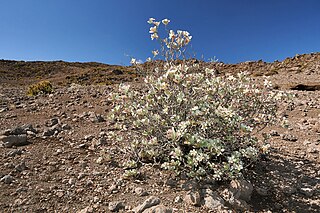
Geranium cuneatum, or silver geranium, is a medium alpine shrub endemic to the islands of Hawai'i and Maui, where it grows in high elevation shrubland near or above the treeline. Like other geraniums native to Hawai'i, it is known as hinahina in Hawaiian.

Clermontia montis-loa, or Mauna Loa clermontia, is a species of Hawaiian lobelioid endemic to the eastern windward slopes of Mauna Loa on the island of Hawai'i. Like other Clermontia, it is referred to as ʻŌhā wai in Hawaiian.
Cyrtandra lysiosepala, or oppositeleaf cyrtandra, is a species of plant in the Gesneriad family that is endemic to the island of Hawai'i, where it grows in wet tropical rainforests.



















